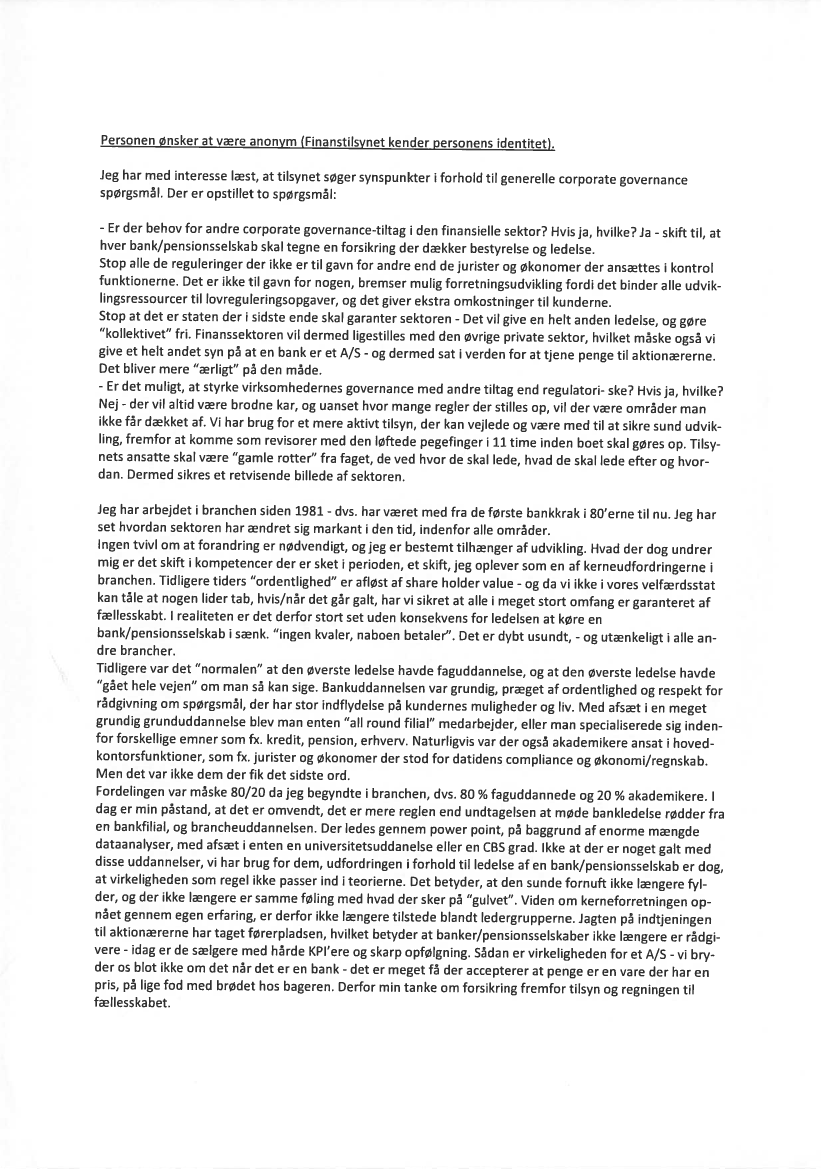
Personen ønsker at være anonym (Finanstilsynet kender personens identitet).
Jeg har med interesse læst, at tilsynet søger synspunkter i forhold til generelle corporate governance
spørgsmål. Der er opstillet to spørgsmål:
Er der behov for andre corporate governance-tiltag i den finansielle sektor? Hvis ja, hvilke? Ja skift til, at
hver bank/pensionsselskab skal tegne en forsikring der dækker bestyrelse og ledelse.
Stop alle de reguleringer der ikke er til gavn for andre end de jurister og økonomer der ansættes i kontrol
funktionerne. Det er ikke til gavn for nogen, bremser mulig forretningsudvikling fordi det binder alle udvik
lingsressourcer til lovreguleringsopgaver, og det giver ekstra omkostninger til kunderne.
Stop at det er staten der i sidste ende skal garanter sektoren Det vil give en helt anden ledelse, og gøre
“kollektivet” fri. Finanssektoren vil dermed ligestilles med den Øvrige private sektor, hvilket måske også vi
give et helt andet syn på at en bank er et A/S og dermed sat i verden for at tjene penge til aktionærerne.
Det bliver mere “ærligt” på den måde.
Er det muligt, at styrke virksomhedernes governance med andre tiltag end regulatori- ske? Hvis ja, hvilke?
Nej der vil altid være brodne kar, og uanset hvor mange regler der stilles op, vil der være områder man
ikke får dækket af. Vi har brug for et mere aktivt tilsyn, der kan vejlede og være med til at sikre sund udvik
ling, fremfor at komme som revisorer med den løftede pegefinger i 11 time inden boet skal gøres op. Tilsy
nets ansatte skal være “gamle rotter” fra faget, de ved hvor de skal lede, hvad de skal lede efter og hvor
dan. Dermed sikres et retvisende billede af sektoren.
-
-
-
-
-
-
Jeg har arbejdet i branchen siden 1981 dvs. har været med fra de første bankkrak i 80’erne til nu. Jeg har
set hvordan sektoren har ændret sig markant i den tid, indenfor alle områder.
Ingen tvivl om at forandring er nødvendigt, og jeg er bestemt tilhænger af udvikling. Hvad der dog undrer
mig er det skift i kompetencer der er sket i perioden, et skift, jeg oplever som en af kerneudfordringerne i
branchen. Tidligere tiders “ordentlighed” er afløst af share holder value og da vi ikke i vores velfærdsstat
kan tåle at nogen lider tab, hvis/når det går galt, har vi sikret at alle i meget stort omfang er garanteret af
fællesskabt. I realiteten er det derfor stort set uden konsekvens for ledelsen at køre en
bank/pensionsselskab i sænk. “ingen kvaler, naboen betaler”. Det er dybt usundt, og utænkeligt i alle an
dre brancher.
Tidligere var det “normalen” at den Øverste ledelse havde faguddannelse, og at den øverste ledelse havde
“gået hele vejen” om man så kan sige. Bankuddannelsen var grundig, præget af ordentlighed og respekt for
rådgivning om spørgsmål, der har stor indflydelse på kundernes muligheder og liv. Med afsæt i en meget
grundig grunduddannelse blev man enten “ali round filial” medarbejder, eller man specialiserede sig inden
for forskellige emner som fx. kredit, pension, erhverv. Naturligvis var der også akademikere ansat i hoved
kontorsfunktioner, som fx. jurister og Økonomer der stod for datidens compliance og økonomi/regnskab.
Men det var ikke dem der fik det sidste ord.
Fordelingen var måske 80/20 da jeg begyndte i branchen, dvs. 80 % faguddannede og 20 % akademikere. i
dag er min påstand, at det er omvendt, det er mere reglen end undtagelsen at møde bankledelse rødder fra
en bankfilial, og brancheuddannelsen. Der ledes gennem power point, på baggrund af enorme mængde
dataanalyser, med afsæt i enten en universitetsuddanelse eller en CBS grad. Ikke at der er noget galt med
disse uddannelser, vi har brug for dem, udfordringen i forhold til ledelse af en bank/pensionsselskab er dog,
at virkeligheden som regel ikke passer ind i teorierne. Det betyder, at den sunde fornuft ikke længere fyl
der, og der ikke længere er samme føling med hvad der sker på “gulvet”. Viden om kerneforretningen op
nået gennem egen erfaring, er derfor ikke længere tilstede blandt ledergrupperne. Jagten på indtjeningen
til aktionærerne har taget førerpladsen, hvilket betyder at banker/pensionsselskaber ikke længere er rådgi
vere idag er de sælgere med hårde KPI’ere og skarp opfølgning. Sådan er virkeligheden for et A/S vi bry
der os blot ikke om det når det er en bank det er meget få der accepterer at penge er en vare der har en
pris, på lige fod med brødet hos bageren. Derfor min tanke om forsikring fremfor tilsyn og regningen til
fællesskabet.
-
-
-
-
-
-